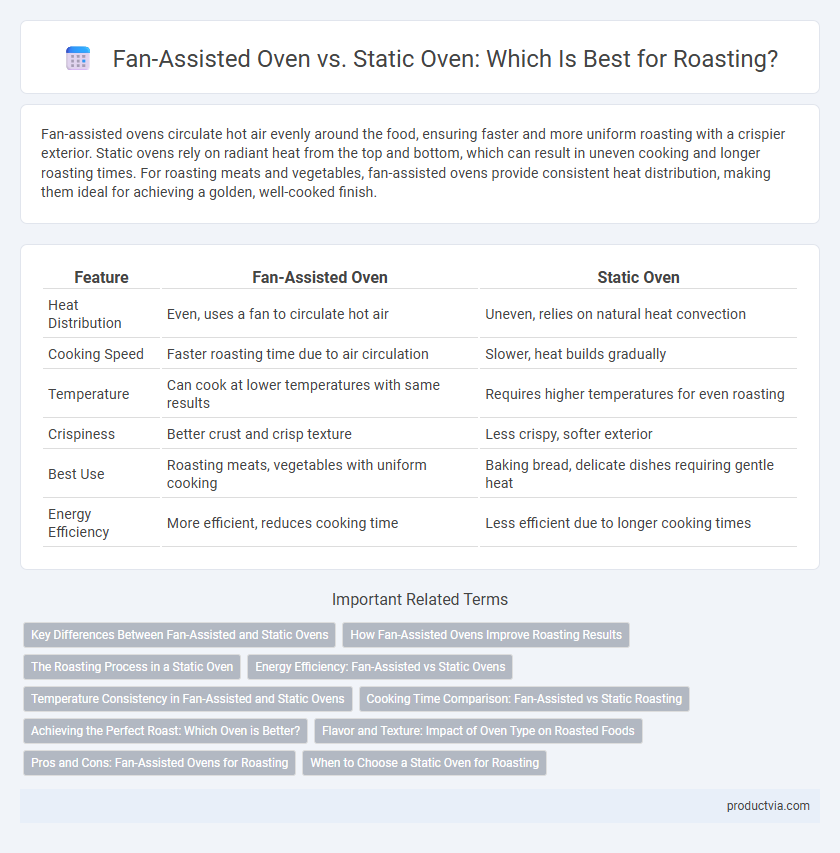Fan-assisted ovens circulate hot air evenly around the food, ensuring faster and more uniform roasting with a crispier exterior. Static ovens rely on radiant heat from the top and bottom, which can result in uneven cooking and longer roasting times. For roasting meats and vegetables, fan-assisted ovens provide consistent heat distribution, making them ideal for achieving a golden, well-cooked finish.
Table of Comparison
| Feature | Fan-Assisted Oven | Static Oven |
|---|---|---|
| Heat Distribution | Even, uses a fan to circulate hot air | Uneven, relies on natural heat convection |
| Cooking Speed | Faster roasting time due to air circulation | Slower, heat builds gradually |
| Temperature | Can cook at lower temperatures with same results | Requires higher temperatures for even roasting |
| Crispiness | Better crust and crisp texture | Less crispy, softer exterior |
| Best Use | Roasting meats, vegetables with uniform cooking | Baking bread, delicate dishes requiring gentle heat |
| Energy Efficiency | More efficient, reduces cooking time | Less efficient due to longer cooking times |
Key Differences Between Fan-Assisted and Static Ovens
Fan-assisted ovens use a built-in fan to circulate hot air evenly around the food, creating a consistent temperature ideal for roasting meats and vegetables quickly and uniformly. Static ovens rely on heat radiating from the top and bottom elements without air circulation, producing a gentler, less intense heat better for slow roasting and baking delicate items. Fan-assisted ovens generally achieve faster cooking times and more even browning, while static ovens preserve moisture and texture in foods requiring longer cooking durations.
How Fan-Assisted Ovens Improve Roasting Results
Fan-assisted ovens distribute heat evenly by circulating hot air, which accelerates cooking times and ensures uniform browning during roasting. This consistent air flow reduces hot spots, producing tender and juicy meats with crispy exteriors. Roasting in a fan-assisted oven enhances caramelization, resulting in richer flavors compared to static ovens.
The Roasting Process in a Static Oven
Roasting in a static oven relies on radiant heat from the oven walls, producing a gentler and more even cooking environment ideal for large cuts of meat. The slower heat transfer helps maintain moisture and develop a golden-brown crust without drying the surface. This method suits traditional roasting techniques, ensuring tenderness and rich flavor through gradual temperature penetration.
Energy Efficiency: Fan-Assisted vs Static Ovens
Fan-assisted ovens use a built-in fan and exhaust system to circulate hot air, which enables more even and faster cooking, leading to reduced cooking times and lower energy consumption compared to static ovens. Static ovens rely on natural convection without a fan, resulting in uneven heat distribution and longer cooking durations, increasing energy usage. Studies show fan-assisted ovens can be up to 20% more energy-efficient for roasting tasks due to improved heat circulation and temperature control.
Temperature Consistency in Fan-Assisted and Static Ovens
Fan-assisted ovens maintain more uniform temperature distribution by circulating hot air with a built-in fan, resulting in even roasting and consistent browning. Static ovens rely on radiant heat from the top and bottom elements, often causing temperature variations and hotspots that can lead to uneven cooking. Temperature consistency in fan-assisted ovens enhances roasting precision, reducing the need for frequent monitoring and adjustments.
Cooking Time Comparison: Fan-Assisted vs Static Roasting
Fan-assisted ovens reduce cooking time by circulating hot air evenly around the food, achieving faster and more consistent roasting results compared to static ovens. Static ovens rely on radiant heat from the top or bottom, often requiring longer cooking times due to uneven heat distribution. For roasting meats and vegetables, fan-assisted ovens can cut cooking time by up to 25%, enhancing energy efficiency and preserving moisture.
Achieving the Perfect Roast: Which Oven is Better?
Fan-assisted ovens provide consistent heat circulation, ensuring even cooking and reducing roasting time, which is ideal for achieving a perfectly browned and juicy roast. Static ovens rely on radiant heat from the top and bottom elements, offering a traditional roasting environment that excels in slow cooking tougher cuts by retaining moisture. For precision roasting with crisp exteriors and tender interiors, fan-assisted ovens deliver superior results compared to static ovens.
Flavor and Texture: Impact of Oven Type on Roasted Foods
Fan-assisted ovens circulate hot air evenly around food, promoting uniform roasting and enhancing caramelization, which intensifies flavor and produces a crispy, golden crust. Static ovens rely on radiant heat from the top and bottom, creating a slower, gentler cooking process that preserves moisture, resulting in tender, juicier interiors but less pronounced browning. Choosing between fan-assisted and static ovens for roasting affects the balance between crisp texture and succulent flavor, with fan-assisted ideal for even, flavorful crusts and static preferred for moist, delicate finishes.
Pros and Cons: Fan-Assisted Ovens for Roasting
Fan-assisted ovens distribute heat evenly through a convection fan, resulting in faster and more uniform roasting, which helps achieve crispy exteriors and juicy interiors. They reduce cooking time and energy consumption but may cause delicate foods to dry out if not monitored closely. In contrast, static ovens provide gentler, radiant heat ideal for slow roasting but often require longer cooking times and can lead to uneven browning.
When to Choose a Static Oven for Roasting
Choose a static oven for roasting when cooking large cuts of meat or whole poultry to achieve even browning and caramelization without drying out the exterior. Static ovens provide consistent dry heat, which is ideal for slow roasting and preserving the natural moisture of the food. Avoid using fan-assisted mode with delicate roasts to prevent uneven cooking and excessive surface drying.
Fan-assisted oven vs Static oven for roasting Infographic

 productvia.com
productvia.com